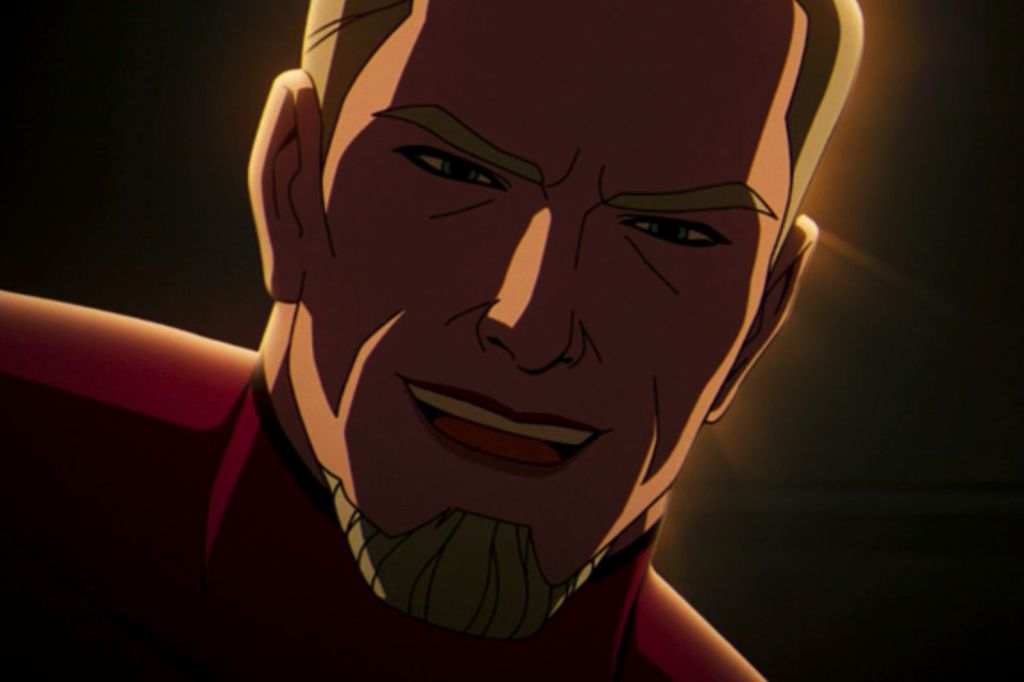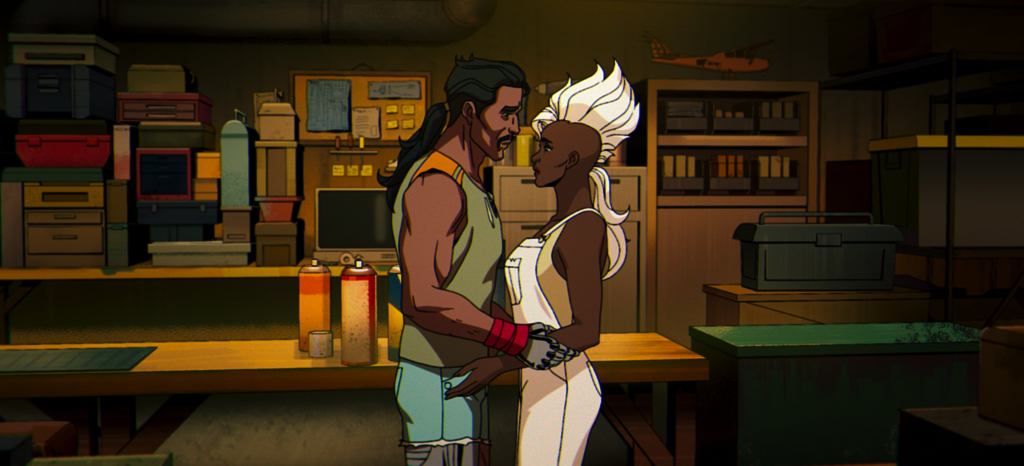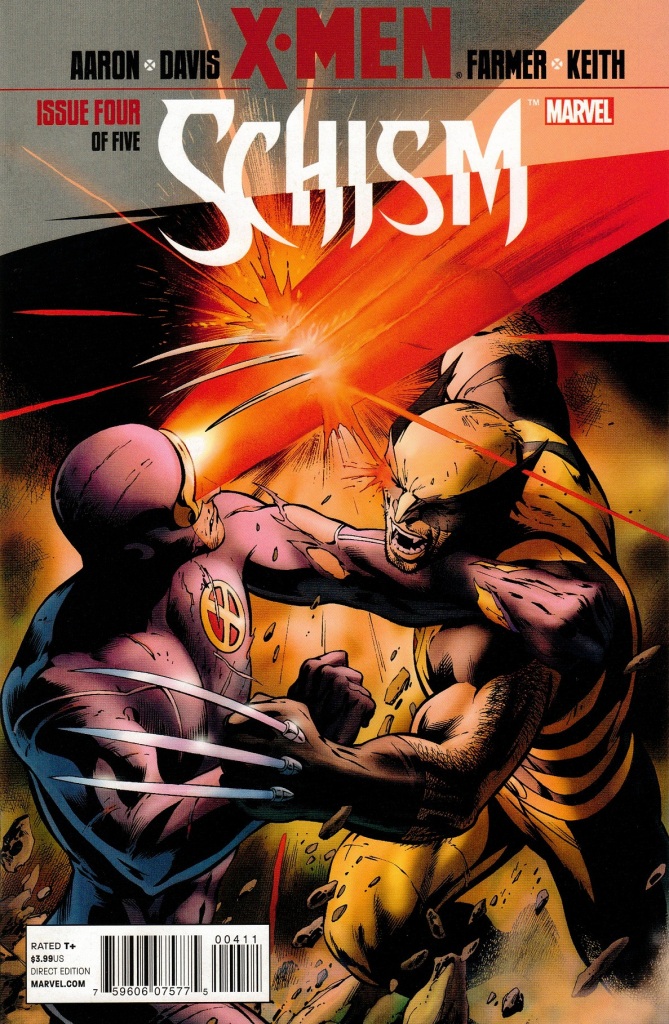
Finally, some good fucking food.
Editor’s Note: Spoilers Throughout
I don’t need to go through m y whole torrid relationship with comics, but I can say that I love them more than I read them and that the reason I care about comics is because of Fox’s early X-Men movies, Sony’s Sam Raimi Spider-Man movies, Burton-and-Schumacher Batman, and the cartoons of the 1990s that came out starring these same characters and which were replayed on Disney, Cartoon Network and their spinoff channels when I was a lad. X-Men ’97 is a worthy successor to the X-Men show of the 1990s to which it is a direct sequel (complete with mainly copying and slightly updating the iconic theme music) and to the other X-Men series that have come out in the intervening years. It is much better than I have any expectation of the MCU X-Men being, and it is a successor to a children’s show which feels like it respects that its audience is adults. It doesn’t just pander to our need for nostalgic comfort, it also challenges our expectations by asking the sort of poignant and controversial questions that the X-Men’s stories always have, creating an emotionally challenging and mature adaptation of several comic runs. Moreover, by deign of its maturity, adolescents (who *should* be the intended audience) will find it does not condescend.
I sort of avoided it at first, having no expectation it would really deliver what I needed or wanted from it. Then I heard about the carnage of the fifth episode and dove in, knowing that what we were getting wasn’t just an adaptation of X-Men comics, but a show that took seriously the dark depths of its themes. By the time I got to episode 5, “Remember It,” I remembered something very bad was going to happen but was not certain of the details; into the final minutes, I was thinking I must have misinterpreted what I read, until the final death. I watched it on May 1st and was left speechless for fifteen minutes of its thirty-minute runtime; I rewatched that second half later that night.
It’s only ten episodes which isn’t enough to truly satiate my craving for quality superhero output, but it does whet my appetite for more X-Men; revisiting the predecessor show to fill in backstory I forgot or never knew, maybe revisiting some of the mixed bag of Fox films. Regardless, X-Men ’97 is an exceptionally well-executed ten episodes as it is, with a spectacular three-episode finale.
It’s drawing on Grant Morrison, Chris Claremont, and other X-Men runs I’m not personally familiar with to show the X-Men, as ever, fighting to protect a world that hates and fears them. The show begins with wealthy telepathic geneticist/psychologist Professor Charles Xavier presumed dead, willing all his earthly effects and his control of the X-Men to longtime friend and nemesis Magneto. We meet Roberto Da Costa, filling in the new audience member role that Jubilee provided in the original series. Morph returns, shapeshifting powers tuned way up and used to do visual Easter Egg cameos with other Marvel characters in a way that has practical viability in the many excellent combat sequences. Truly, the fight scenes are engaging and exquisite.
Like, the animation is just so cool and enticing and reminds, occasionally, of a resolution-improved version of the Marvel vs. Capcom arcade game, but mostly of the comics come to life. But, as I believe the hosts of Jay & Miles X-Plain the X-men have said, the comic is a mutant soap opera. And here, things are about to get a bit difficult to parse if you don’t recognize any of the character names…
So, in this series we meet Jean Grey’s doppelganger Madelyne Pryor through intense circumstances of Jean showing up on the doorstep of the X-Mansion at the end of the first episode after Scott and who we thought was Jean were planning to leave the team. The revelation of her existence throws Cyclops and Jean Grey’s relationship into turmoil while Magneto is trying to honor Professor X’s vision of mutant-human coexistence. While we, perhaps strangely, never see Magneto’s Brotherhood of Evil Mutants outside of the opening credit sequences, his very presence on the team creates tension, throwing a wrench into Rogue and Gambit’s fraught relationship. In the second episode of the season, Storm loses her weather witch powers while taking a shot from an anti-mutant vigilante’s de-powering gun. Magneto shows mercy upon mercy and is punished for it.
As Storm travels and meets Forge, she does battle with a psychic monster and regains her powers. Meanwhile, Jubilee and Sunspot deal with Sunspot’s wealthy parents and his evasion of the spotlight. The mutant metaphor of special people oppressed by the dominant group while a few members of the minority are able to excel and attempt to bring everyone up by being palatable superheroes has become more tightly tied with queerness than ethnicity over the past few decades. It’s never clearer than when the proverbial closet enters the fray.
Eventually, we reunite with old friends like Nightcrawler and are treated to small shots of myriad minor characters on the island of Genosha, with whole romantic storylines playing out in the background. Formerly a place of mutant enslavement, a new mutant society has been established, with the likes of Hellfire Club leaders Emma Frost and Sebastian Shaw requesting Magneto join them. Then, while the mutants are partying and Ace of Base’s Happy Nation plays, a devastating attack takes place, some of the most startling and intense imagery I have seen in an American cartoon targeted at adolescents. Sentinels, the giant mutant-killing robots, are deployed from a giant insectoid-sentinel that is also launching tremendous bursts of energy that act with the force of megatons of explosives. Thousands die.
The ensuing battle is impressive for its seeming futility, all the carnage intentional by the Sentinels and incidental collateral damage during the mutant response. It’s harrowing. It’s likely to remind you of images of natural disasters and of man-made catastrophes and massacres such as, it must be said, the ongoing destruction of the Gaza Strip or the 2016 Pulse nightclub massacre.
The politics of the mutant metaphor (i.e. mutants for any given marginalized group, sometimes paired with the imprecise, incurious, and inelegant analogy of Xavier as MLK and Magneto as Malcolm X) can never be 1:1 exact, and aren’t intended to be, I don’t think. But the Krakoa era rested on a complicated idea about mutants developing their own island nation separate from everyone else, bribing and blackmailing on a global scale for recognition, and creating a cruel and strange social structure in many ways. I’m relatively early in the Krakoa run (it began in 2019 and just wrapped up so I have a lot to read) so I will hold my judgment on its political efficacy or aesthetic effectiveness. What I will say is that this snapshot of Genosha ties in several different stories (I heard Mutant Massacre and E for Extinction referenced on The Mutant Ages) and exemplifies a tendency throughout the show to pull stories direct from the comics and combine them in ways that respect the original creative intention while leaving room for adaptative growth.
There are two episodes of fallout as the character Bastion is introduced as the source of the beyond-conceivable-scale Sentinel army, leading into a three-part finale which ties in Asteroid M/Avalon, Magneto’s extra-terrestrial base, and ending on an incredible time-splitting cliffhanger. The X-Men eventually try to save him, as they’re bound to doing by organizational ideology and editorial decree, but only because of their great well of empathy, belief in Xavier’s dream, and after fighting him for a very long time.

Bastion is a sort of post-human that maybe isn’t *quite* a mutant but has powers tied to the creation and manipulation of technology, and plans to usher in an age of human-sentinel hybrids destroying and enslaving mutants to create a utopia. Magneto is provoked to counter his plan, throwing the world into chaos by using his electromagnetic powers to wipe out power across the country. We get even more touching moments drawn from the comics, and one incredibly violent one in particular, while the ethics of the deployment of the Professor’s psychic powers are disputed and tested. Xavier enters Magneto’s mind, helping Magneto piece together his psyche in a bar on a sort of astral plane (but not the Astral Plane) after seizing control of his mind to reverse Magneto’s catastrophe.
The show is vibrant and enticing throughout, with great voice acting[1] and terrific writing. I’m so impressed by how quickly they have used so much of the history of the characters, though paced in such a way that they still have so much yet to draw from. The relationship between Cable and his parents is teased out very well in not a lot of time, with Mr. Sinister meddling, suppressed angst inside Cable being channeled in a way that made me think of when Vegeta was Majin, and eventually an emotional reckoning and reconciliation between Scott, Jean, and Nathan. There’s more than a few touching moments; the characters are so compelling. The series ends with the mutant heroes just barely preventing Asteroid M from crashing into the planet and then being displaced in time – with many of them ending up in the 4th millennium B.C., meeting a young Apocalypse and Scott and Jean in the future meeting a young Cable.
And with all those spoilers I’m still trying to leave stones unturned. I think the show does do some things that make you wonder “how did that happen?” but moves quickly and effectively enough that you may be too compelled to engage with what’s going on to get stuck on those questions. The second part of the finale ends with Magneto having placed his helmet over Xavier’s head to block Xavier’s powers and Magneto pulling the adamantium out of Wolverine’s skeleton. The third episode begins with Xavier in Magneto’s head. There are a couple issues like this throughout the series, but I attribute it to trying to get a lot done in just ten episodes. I hope the next season has at least 16 if not 22-26. We need full orders. I feel the show has proven its worthiness to stay around. I haven’t been this interested in an audiovisual Marvel project since I’m not sure when. When I play Marvel’s Midnight Suns, these are the sort of comic book adventures and relationships I am harkening for.[2] I think the show does enough dramatically and aesthetically to handwave some of the structural issues like that (or like the lack of millions of people dying immediately due to a global EMP; I mean, people might have, it hasn’t really been discussed). I felt the episode which spends half its time on Jubilee and Sunspot in a Mojoverse computer game is sort of the weakest except that it helps establish a connection to something else from the past and, moreover, shows proof of concept for doing off-beat episodes. Introducing the Shi’ar is crucial to Professor X’s arc at this stage, but we only get one episode with them really, and expect they will be back next season. I wonder if Cyclops’s anger at humanity will rear its head; at one point (during an ill-fated interview during “Remember It”), I expected him to end up on the more militant side, but I guess they may wait a couple seasons something like the “Schism” storyline to play out.
At the end of it all, so much of this show is relying on payoff in next season because of how much it set up, but the stellar episode 5 and they very strong episodes which followed it will give it an exalted place in critical consideration even if it doesn’t fully deliver (which seems very possible since they parted ways with one of their most prominent creative voices). But that’s how serial storytelling works; that’s why these stories work better as a television series with time to build up characters and have them interact with each other than as movies with compressed character arcs.
X-Men ’97 is a solidly entertaining show that took its subject matter seriously, which is all I could hope for and more than I expected. There were occasional moments of levity that felt misplaced, but not overwhelming on the order of most Marvel stuff. There are some cameos from other Marvel characters, but they are mostly very brief and work in the way I like for X-Men interactions with non-X-Men characters to work: angrily asking where their supposed human allies were when they were dying. Captain America is the main character to come in as a target for Rogue’s ire. Spider-Man and the Silver Samurai have a few cameo reaction shots. Black Panther (King T’Chaka) figures as a small part in the finale.
It’s just very fun to watch. I’d like to take more time and cut this down, but that’s what it comes down to. The creative team[3] utilize a bunch of comic arcs from the 90s to create a compelling story connecting them in a naturalistic way that highlights the frustrations of fighting for people that don’t love you, and the tension between respectability, assimilation, and liberation. It’s not an intrinsically revolutionary text but I don’t think anyone is really expecting that. What it does avoid is being overly conciliatory. It doesn’t lack backbone or grit. I just think it needs more time, and hope it gets some next season. There’s every chance I rewatch it before then, at least once I finish 1992-1997’s X-Men. It’s good eating.1
Final Score: 4/5
All episodes of X-Men ’97 are now streaming on Disney+
[1] Alison Sealy-Smith reprises her role as Storm from the 1992-1997 cartoon, as does Carl Dodd with Wolverine, Lenore Zann reprises her role as Rogue, George Buza reprises his role as Beast, A.J. LoCascio reprises his role as Gambit, Adrian Hough reprises his role as Nightcrawler. Jennifer Hale, who voiced Jean Grey in Wolverine and the X-Men replaces original series voice actor Catherine Disher. Ray Chase voices Cyclops in place of Norm Spencer, who died in 2020. Hale and Chase said they based their performances off of Disher and Spencer, respectively. Holly Chou replaced Alyson Court as Jubilee; Court said she would prefer an Asian voice actress voice Jubilee, but she does appear in a small role in the Mojo videogame world episode. Ross Marquand replaces Cedric Smith as Professor X.
[2] I also really miss X-Men Legends, but it’s been almost 20 years since a proper game in that series.
[3] My biggest concern is that creator Beau DeMayo was fired before the premiere, although writing for the second season was finished this spring.
- Something I meant to mention, since I don’t now if I’ll ever get around to doing a post that’s just a list of podcast recommendations… The first comics podcast I listened to was Jay and Miles X-Plain the X-Men, when I was in grad school trying to build my comic knowledge to get a job at my frequented comic shop. They go through every story in pretty much publication order, with occasional breakages, guest spots, and convention panels. Also co-host Jay Edidin wrote an excellent Cyclops story in Marvels: Snapshots. I listened to the first 300 episodes nearly back-to-back into the winter of 2018-2019 (mixed in with stuff like Davos’ Fingers), though I’ve fallen a bit behind. Cerebro is an incredible deep-dive that goes character by character featuring guests discussing their favorite characters. Battle of the Atom is really entertaining and is making a quality ranking of every X-Men issue – I haven’t listened especially recently but I’ve always enjoyed it. The Mutant Ages is analyzing and reviewing every TV and film adaptation of the X-Men comics – I haven’t listened to them as frequently recently, but they became one of my comfort podcasts last year. All these podcasts have different tones, but they’re all pretty queer, because we see ourselves in the X-Men and have for a long time. There’s also Marvelous, or the Death of Cinema, a podcast that analyzes MCU films and their impact on the film industry. One really prominent comic fan went from a special correspondent to a main host and they’ve covered some X-Men stuff. ↩︎




